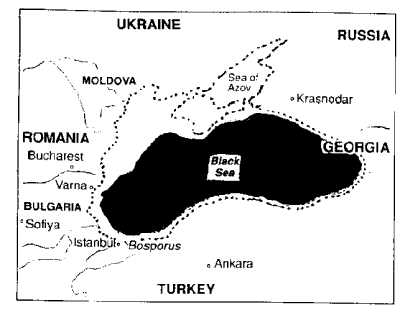 |
Science Frontiers ONLINE No. 117: May-June 1998 |
|
|
Two Catastrophe Scenarios
We present below two reconstructions of major terrestrial catastrophes. Both are based on sound geological research: deep-sea cores, seismic profiles, and the like; but the reconstructions of the events are on the speculative side, particularly in matters of the magnitudes of the effects. Both events also purport to explain long-standing puzzles.
Scenario #1. The Bosporus silt plug blows. During the last Ice Age, sea levels dropped hundreds of feet exposing the continental shelves. The planet's great rivers cascaded over the edges in great waterfalls. The rocky sill at Gibraltar kept the Atlantic waters out of the Mediterranean, and this sea began to dry up. Farther to the east, the Black Sea was now cut off from the Mediterranean's salty water by the silt-choked Bosporus, that narrow strait separating Asia Minor from Europe. In consequence, the Black Sea became a vast fresh-water lake fed by Europe's rivers to the north.
The Ice Age eventually waned, and the oceans and Mediterranean began to rise. About 7,000 years ago, the hydraulic pressure on the Bosporus silt plug became too great and it popped. Salty Mediterranean water poured into lowlands around the Black Sea. Scientists estimate that 50 cubic kilometers of water surged through the Bosporus each -- 200 Niagaras in one colossal waterfall. Falling some 150 meters, the thunder of falling water might have been heard 500 kilometers away! The Black Sea rose quickly, driving the shoreline and humans back a kilometer or two every day.
The fleeing Neolithic farmers were forced up into the rich river valleys of Europe, carrying tales of the catastrophe as well as their culture and agricultural know-how into these areas. The Middle East was affected, too. The traumatic experiences of the survivors may have been the basis for the Sumerian and Biblical flood stories.
(Mestel, Rosie; "Noah's Flood," New Scientist, p. 24, October 4, 1997. Also: Kerr, Richard A.; "Black Sea Deluge May Have Helped Spread Farming," Science, 279:1132, 1998.)
Scenario #2. The Eltanin asteroid hits. About 2.2 million years ago, a chunk of space debris about a kilometer in diameter splashed down in the Bellingshausen Sea between Antarctica and South America. It was some splash! The splash zone was about 20 kilometers across, waves 4 kilometers high raced away from Ground Zero, and a column of salt water ascended miles high into the upper atmosphere. The TNT equivalent is estimated at 12 billion tons. Ice clouds formed and shaded the planet, causing severe climate changes. On the floor of the Bellingshausen Sea, 5 kilometers deep, lies the Eltanin Impact Structure.
Today, we can still see the geological consequences thousands of kilometers from the impact point. The puzzling remains of marine diatoms in Antarctica's dry valleys may well be fallout from the cubic kilometers of seawater blasted out of the Bellingshausen Sea. More formidable were the giant tsunamis that fanned out at jet speeds toward South America and Australia. On the deep ocean these tsunamis were only 20-40 meters high, but as they approached land, they slowed and piled up into walls of water that approached a kilometer in height. Even after 2.2. million years, geologists think they can see traces of these tsunamis in Australia and New Zealand. The mysterious bone beds near Pisco, Peru, may also have been the work of the tsunamis. Here, geologists find a deposit containing bones of both marine and terrestrial animals mixed together as if by a giant blender.
(Hecht, Jeff; "A Bigger Splash," New Scientist, p. 11, November 1, 1997. And: Anonymous; "The Splash Felt 'round the World," Earth, 7:12, April 1998.)
 |
When the Bosporus silt plug ruptured, the Black Sea filled and expanded to the dotted outline. |